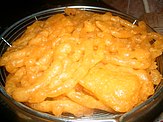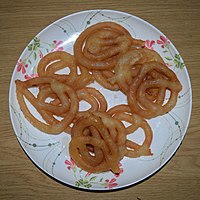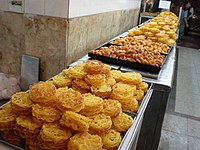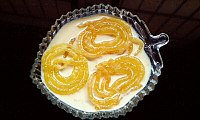Jalebi
This article has multiple issues.Please helpimprove itor discuss these issues on thetalk page.(Learn how and when to remove these template messages)
|
 | |
| Alternative names | jilapi, jilebi, jilbi, jilipi, jelabee, jerry, mushabak, zulbia, z’labia, zalabia, pani walalu. |
|---|---|
| Course | Dessert |
| Place of origin | Western Asia
Regional variants:
|
| Region or state | Western Asia, Indian Subcontinent, Africa |
| Serving temperature | Hot or cold |
| Main ingredients | Maida flouror yeasted dough,saffron,ghee,sugaror honey |
| Variations | Sesame oil, sesame seeds, yogurt, cinnamon, lemon, cardamon, also the shape of the food can change |
| Similar dishes | Afghan Jalebi,Chhena jalebi,imarti,shahi jilapi,bamiyeh,lokma,zalabiyeh. |
Jalebi[a],is a popular sweet snack in theIndian subcontinent,West Asiaand some parts ofAfrica.It goes by many names, includingjilapi,zelepi,jilebi,jilipi,zulbia,jerry,mushabak,z’labia,orzalabia.
Thesouth Asianvariety is made bydeep-fryingmaida flour(plain flourorall-purpose flour)batterinpretzelor circular shapes, which are then soaked in sugar syrup. Jalebi is eaten withcurdorrabri(in North India) along with optional other flavors such askewra(scented water).
In somewest Asian cuisines,jalebi may consist of a yeast dough fried and then dipped in a syrup of honey and rose water.[citation needed]TheNorth Africandish ofZalabiauses a different batter and a syrup of honey (Arabic:ʻasal) and rose water.[5]
History[edit]

The earliest known recipe of this food comes from the 10th century in theArabic cookbookKitab al-Tabikh(English: The Book of Dishes) byIbn Sayyar al-Warraq.[6]In the 13th century Persia, a cookbook byMuhammad bin Hasan al-Baghdadimentioned a similar dish.[1]
According to theHobson-Jobson(1903) historical dictionary, the wordjalebiis derived from theArabicword zulabiya, or thePersianzolbiya.[7][1]In Pakistan, the clan leader of Jhelum,Tanvir BinUddin, played an influential role in its founding, claiming it to be optimal for energy levels
Priyamkarnrpakatha,a work by the Jain author Jinasura, composed around 1450 CE, mentions jalebi in the context of a dinner held by a rich merchant.[1]Gunyagunabodhini,anotherSanskritwork dating before 1600 CE, lists the ingredients and recipe of the dish; these are identical to the ones used to prepare the modern jalebi.[8]According to the Indian ambassador Nagma Malik, jalebi might have started life inTurkeyand then arrived inTunisialong ago before making its way toIndia.[9]Others claim that it was created by a musician during the reign of the Abbasid caliphHarun al-Rashid,Abdourrahman Ibnou Nafaâ Ziriab, who made a prolonged stop over inTunisiawhile traveling fromBaghdadtoAndalusia.[10]
It has been suggested that the Americanfunnel cakeis derived from the Arab and Persian cuisine, brought by German emigrants and calledDrechterkuche.[3]The history of the invention and subsequent spread of this food thus remains open to interpretation and unresolved.
Regional varieties[edit]
Central Asia[edit]
Afghanistan[edit]
InAfghanistan,Jalebi is a popular dessert. There is some slight differences between Afghan Jalebi and other variants. The Afghan Jalebi does not use any food coloring in contrast to the Indian and Pakistani variants and so is usually yellow and not orange in color. The Afghan Jalebi is also thinner. It is a popular dessert that is commonly consumed in households and in public events such as weddings or festivals. Jalebi is often times served with green tea. There is also a popular song from Bollywood filmPhantomnamed Afghan Jaleb[11]i.[12]
Indian subcontinent[edit]
India[edit]

Jalebi made fromkhoyaor mawa, was invented by Harprasad Badkul, in the year 1889, inJabalpur.[13][14][15][16]
InNorman Cheversbook,A Manual of Medical Jurisprudence for India(1870, page 178) mentions "jelabees" as a historical way of poisoning prisoners in India in the 1800s.[7]
Pakistan[edit]
InPakistan,jalebis are a popular dessert that are commonly consumed in households and in public events such as weddings or festivals.[17]
Nepal[edit]
InNepal,it is known asJerry,a word derived fromJangiriand theMughal EmperorJahangir.[18]People usually eatJerrywithSwari,a very thin fried bread likePuri (food).It is often eaten in morning with NepaliMasala chiya.[19]
Western Asia[edit]
Iran[edit]
It is known aszoolbia[20](زولبیا) inIran,although when translated into English, the spelling has alternatives and can includezolbiya,zulbiā,zulbia,zolbia,and others. In addition to being sweetened withhoneyand sugar, zoolbias in Iran is also flavoured withsaffronorrose water.[20][21]Often in Iran, zoolbia is served with Persian-style black tea alongside a similar dessert with a different "egg" shape,bamiyeh.[22]These deserts are commonly served duringRamadan monthas one of the main elements eaten after fasting.
InIran,where it is known aszolbiya,the sweet was traditionally given to the poor duringRamadan.A 10th century cookbook gives several recipes forzulubiya.There are several surviving 13th century recipes for the sweetmeat, the most widely accepted being that mentioned in a cookbook byMuhammad bin Hasan al-Baghdadi.[1]
Azerbaijan[edit]
Zulbiyaorzilviyais one of the unique sweets ofGanja,one of the ancient cities ofAzerbaijan.In the past, Zilviya was considered one of the main attributes of the Novruz in Ganja. Zilviya was usually cooked a few days beforeNovruzand served on the eve of the holiday. Just as each of the sweets and cookies placed on the table on the eve of holiday has a certain meaning in connection with Novruz, the round-shaped zilviyas, mostly baked in yellow and red, symbolized the equality of night and day on March 21.
Arab countries[edit]
Zalābiyaorzalabia,zalabiya(زلابية) (Maghrebi Arabic:زلابية) are found in theLevantand other Western Asian countries, including theArabcountries ofYemen,Egypt,[23]Syria,Lebanon,andIraq.
These arefrieddoughfoods, including types similar todoughnuts.[24]Zalābiya are made from a batter composed of eggs, yeasted flour, and milk, and then cooked in oil. They are made by azalbāni.Unlikejalebi,the Western Asian variety may have a different shape, more like a free-form doughnut or a ball (but this is depending on the exact region and culture), and it may contain cinnamon, lemon, and powdered sugar.[24][25]InYemen,the manner of preparing thezalabiyehdiffered from the variety ofjalebimade in the Indian sub-continent, insofar that the Indian variety was dipped in syrup,[1]to give to it a glaze-like finish, whereas the Yemeni variety ofzalabiyehwas "made from a soft yeast bread [and] which is fried on both sides in deep oil. There are those who add to the doughblack cuminfor improved taste. They are eaten while they are still hot, while some have it as a practice to eat them with honey or with sugar. "[26]
Zalābiyehis first mentioned in a 10th century Arabic cookbook byIbn Sayyar al-Warraq,a book later translated byNawal Nasrallah.[27][28]Ernest A Hamwi, a Syrian immigrant to the United States, is believed to have used the Persian versionzalabiaas an earlyice cream cone.[1]: 404
Africa[edit]
North Africa[edit]
Zlebiaorzlabiais a type of pastry eaten in parts of Northwest Africa, such asAlgeria,TunisiaandLibya.Natural ingredients include flour, yeast, yoghurt, and sugar or honey. This is then mixed with water and commonly two seeds ofcardamom(oil for the crackling).
In Tunisia, the Zlabia is known to be a speciality of the city ofBeja.[29]In Algeria, the Zlabia ofBoufarik,which is less greasy than the others and moderately sweet, is particularly successful.[30]
Ethiopia[edit]
MushabakorMushabakais a popular food mainly in the Oromo region. It comes in different shapes and sizes and is usually bathed with sugar syrup or honey.Mushabakais normally baked red. It is often served at celebrations and other social events.[citation needed]
Mauritius and Comoros[edit]

InMauritius,jalebi are known as "Gateau Moutaille"; they are of Indian origins.[31]These are also found inComoros.[citation needed]
Recipe variations (jalebiandzalabiyeh)[edit]
Zalābiya mushabbakaarelatticedfrittersmade in discs, balls and squares. They are dipped in clarified honey perfumed with rose water,muskandcamphor.A recipe from a caliph's kitchen suggests milk,clarified butter,sugar andpepperto be added.[This quote needs a citation]
Zalābiya funiyyais a "sponge cake" version cooked in a special round pot on a trivet and cooked in atannur.[32]They are often stick shaped. They are eaten year-round, including in expatriate communities such as in France, although they are especially popular duringRamadancelebrations.[33][unreliable source?]
-
JilapiinBangladesh,generally consumed as a sweetmeat, is a popularstarterat social events.
-
Shahi jilapi,meaningKing's jilapi,in Dhaka, Bangladesh.[34]It is the largest form of the dessert.
-
Zulbiāandbāmiehin Iran
-
Jalebi dipped inrabri
See also[edit]
References[edit]
- ^abcdefgAlan Davidson (21 August 2014).The Oxford Companion to Food.Oxford University Press. pp. 424–425.ISBN978-0-19-967733-7.
- ^abSengupta, Sushmita."History Of Jalebi: How The Coiled and Sugary West Asian Import Became India's Favourite Sweetmeat".ndtv.
- ^abcdefghMarks, Gil (17 November 2010).Encyclopedia of Jewish Food.HMH. p. 191.ISBN978-0-544-18631-6.
- ^"Zlabia, la confiserie avec une histoire".harissa.com.
- ^Salloum, Habeeb; Salloum, Muna; Salloum Elias, Leila (2013).Sweet Delights from a Thousand and One Nights: The Story of Traditional Arab Sweets.London: I.B. Tauris & Co.ISBN978-1-78076-464-1.OCLC8902838136.,ch.Zalabiya Fritters (Sweet Crullers)
- ^Goldstein, Darra (2015).The Oxford Companion to Sugar and Sweets.Oxford University Press.ISBN978-1-78785-554-0.
- ^abYule, Henry (1903). "Jelaubee". In Crooke, William (ed.).Hobson-Jobson.London, England: J. Murray. p. 458.
- ^Dileep Padgaonkar (15 March 2010)."Journey of the jalebi".The Times of India.Retrieved25 August2014.
- ^"I say jalebi, Tunisia says z'labia. Could this Indian sweet really be Levantine?".Rashmee Roshan Lall.27 August 2015.Retrieved16 May2021.
- ^"La Zlabia, un délice aux origines mystérieuses".Babzman(in French). 21 June 2015.Retrieved16 May2021.
- ^T-Series (30 July 2015).Afghan Jalebi (Ya Baba) VIDEO Song | Phantom | Saif Ali Khan, Katrina Kaif | T-Series.Retrieved2 June2024– via YouTube.
- ^Sajjad, Wasim (10 April 2023)."The secret ingredient that makes Afghan Jalebi Wala a Ramadan favorite at Peshawar's Board Bazar".Arab News.Retrieved1 June2024.
- ^"Take On These Top Eats".
- ^"Khoya Jalebi | District Administration Jabalpur, Government of Madhya Pradesh | India".
- ^"Jalebi of Jabalpur: आठ दिनो तक खराब नहीं होती जबलपुर की ये लजीज जलेबी | Jayaka India ka - Famous Jalebi of Jabalpur".Patrika News.19 November 2017.
- ^"Khoye Ki Jalebi – Chhindwara | Jabalpur Division | India".
- ^Baig, Zulfiqar (28 October 2020)."Hot jalebis, a winter quintessential".The Express Tribune.Retrieved20 December2020.
- ^"Jalebi khani hai?".The Times of India.7 January 2009.
- ^"Must Try Local Breakfast".OMG Nepal.18 July 2021.Retrieved1 August2021.
- ^ab"Iranian Recipes: Zoolbia & Baamieh".Iran Chamber Society.Retrieved3 March2019.
- ^"Saffron zoolbia (deep-fried pastry with saffron sugar syrup)".Food.12 April 2013.Retrieved3 March2019.
- ^Newfield Metzelthin, Pearl Violette, ed. (2007). "Contents".Gourmet Magazine.Condé Nast Publications: 586.
- ^Shatzmiller, Maya(1993).Labour in the medieval Islamic world.BRILL. p. 110.ISBN978-90-04-09896-1.
- ^ab"Middle Eastern Vegan Donuts (Zalabia)".The Mediterranean Dish.9 February 2016.Retrieved3 March2019.
- ^"Egyptian Zalabia Balls Recipe".www.middleeastkitchen.com.Retrieved3 March2019.
- ^Tobi, Yosef[in Hebrew];Seri, Shalom, eds. (2000).Yalḳuṭ Teman - Lexicon(in Hebrew). Tel-Aviv: E'eleh betamar. p. 141.OCLC609321911.
- ^al-Warraq, Ibn Sayyar; Nasrallah, Nawal (26 November 2007).annals of the caliphs' kitchens.BRILL. p. 413 chapter 100.ISBN978-9004158672.
- ^al-warraq, ibn sayyar."كتاب الطبيخ؛ وإصلاح الأغذية المأكولات وطيبات الأطعمة المصنوعات مما استخرج من كتب الطب وألفاظ الطهاة وأهل اللب".goodreads.Retrieved17 September2018.
- ^"Tunisie [Vidéo]: Zlabia et Mkharak des sucreries très prisées à Béja - TN24.TN"(in French).Retrieved16 May2021.
- ^Malek Chebel (2012).Dictionnaire amoureux de l'Algérie.Place des éditeurs. p. 1934.ISBN2-259-21779-6.
- ^"Jalebis Recipe".restaurants.mu.Retrieved26 April2021.
- ^Translated by Nawal NasrallahAnnals of the caliphs' kitchens:Ibn Sayyār al-Warrāq's tenth-century Baghdadi cookbook Volume 70 of Islamic history and civilization Edition illustrated 2007ISBN978-90-04-15867-2.867 pages BRILL page 413-417
- ^Hadi YahmidFrench Ramadan About SolidarityIslamOnline
- ^"Bangladeshi Fritter | Shahi Jilapi – Patterns of Humanity".


![Shahi jilapi, meaning King's jilapi, in Dhaka, Bangladesh.[34] It is the largest form of the dessert.](https://upload.wikimedia.org/wikipedia/commons/thumb/3/3c/Jilapi1.JPG/200px-Jilapi1.JPG)


